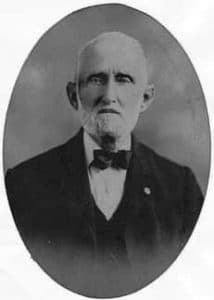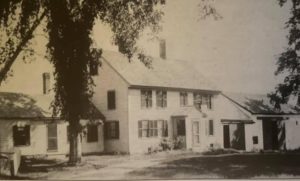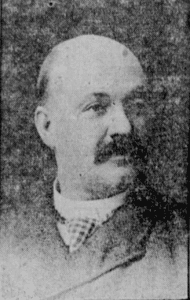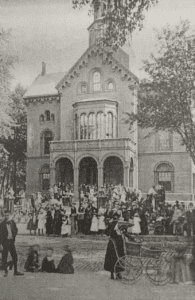 The 1939 play Arsenic and Old Lace by Joseph Kesselring and the later film adaptation by Frank Capra and starring Cary Grant, played out in real life in Wilmington more than a half century before. In the dark comedy, two affable yet murderous spinster sisters set about poisoning their house guests with concoctions of strychnine, arsenic and cyanide. In Wilmington however, the event was far off from the harmless satirical production of stage and screen.
The 1939 play Arsenic and Old Lace by Joseph Kesselring and the later film adaptation by Frank Capra and starring Cary Grant, played out in real life in Wilmington more than a half century before. In the dark comedy, two affable yet murderous spinster sisters set about poisoning their house guests with concoctions of strychnine, arsenic and cyanide. In Wilmington however, the event was far off from the harmless satirical production of stage and screen.
In 1886, Mary Jane Elizabeth Davis was a thirteen-year-old orphan working as a domestic servant for Lizzie Blanchard at her boarding house in Wilmington. In August of that year, she was accused of attempting to murder Ms. Blanchard, her brother and their house guests. Mary Davis was born in Reconstruction Era North Carolina about 1873, most likely to former slaves. Her mother died when she was an infant and her father soon abandoned her. Shuffled about, she eventually came to Boston when she was ten years old. Working as a domestic servant girl in Chelsea and Everett, she came into the employ of Ms. Blanchard during the summer of 1886. The Blanchard House was a farm and boarding house located on Salem Street in North Wilmington. Ms. Blanchard’s guests were often the more well to do of the city who often enjoyed the comfortable summertime country setting and the hospitality offered by her. However, getting on in age, she needed the assistance of suitable domestic help and so came Mary Davis into her home. Mary, however, was not suited for the work and the work was not suited for Mary. On August 27, 1886, Lizzie Blanchard set about to have Mary iron the towels, linens and other laundry for the household and guests. To this task Mary gave quite a complaint and turned surly when scolded by Ms. Blanchard for taking so much time and for doing her chores incorrectly. So mad at Ms. Blanchard did Mary become, she refused to help prepare the nightly dinner. Now at this time Ms. Blanchard’s guests were the Honorable Judge William H. H. Emmons of East Boston and his wife Sarah. Charles Littlefield and his wife Susan were also guests. Both couples had their children with them as well. Also at the house was Samuel Blanchard, Lizzie Blanchard’s brother. The menu of the evening included potatoes and cold meats, fresh rolls and cornbread with peach purée. Tea followed the meal, which Mary Davis gladly prepared, as the guests relaxed and recounted their day. Soon however, they all became violently ill. All vomited and were incapacitated, writhing in pain. Samuel Blanchard was able to summon Special Police Officer Levi Swain, who lived a short distance down the road at the old Pearson Tavern. Officer Swain in turn summoned Dr. Buzzell. Poisoning was immediately suspected by the good doctor, and Mary Davis was soon a suspect. She had been visibly angered by Ms. Blanchard’s chiding and scolding and the victims described her as being pleasantly satisfied with their ill and perhaps fatal circumstances. Then there was her volunteering to prepare the tea after vehemently refusing her other kitchen duties earlier on. Officer Swain investigated the events of the guests and Lizzie and Samuel Blanchard falling deathly ill and found that while all in the household had consumed the dinner, only those that drank the tea had become sick. On August 28, Officer Levi Swain was convinced that he must travel to the courthouse in Malden and obtain an arrest warrant for Mary Davis, charging her with the attempted murders. Officer Swain, however, was not one to miss the seriousness and importance of the crime. He also understood his own situation. While a sworn officer, he was not a seasoned
investigator. Instead, he was a farmer, a shoemaker and an aging veteran of the Civil War. After making his report to the court and swearing a warrant for Mary Davis, he turned the case over to state detective, Inspector Fred Rhoades of the District Police. The District Police (1879-1919) was a precursor agency to the current Massachusetts State Police whose officers worked out of the Commonwealth’s district courts. That day Officer Swain and Inspector Rhoades traveled to Wilmington from Malden and arrested Mary Davis on suspicion of attempted murder. The young girl cried as she was put aboard the state detective’s horse drawn wagon but soon began professing her innocence. She claimed no knowledge of the poisoned tea but rather posited that some Paris Green that had been used on the farm had been dumped into the well. Paris Green was an emerald green crystalline granular substance that was used as an agricultural rodenticide and insecticide. However, Inspector Rhoades’ investigation soon discovered that a container of Rough on Rats poison was missing from the kitchen cupboard. Mary Davis claimed that Ms. Blanchard has used the Rough on Rats, coating bits of bread and leaving them about for the mice. That was fine until Inspector Rhoades collected samples of tea remaining in the teapot, the discarded tea leaves and some of the victims’ vomitus. Analyzed by a Boston laboratory, white crystalline arsenic residue was present in all. Mary Davis was later indicted on several attempted murder charges and she was remanded to the county jail in East Cambridge. On October 29, 1886, after a short trial at Middlesex Superior Court in Lowell, she was found guilty of attempted murder. Lizzie Blanchard and her guests all survived the harrowing, near fatal ordeal. In 1904, during Wilmington’s Old Home Week, Judge Emmons recounted his near-death experience at the hands of the teenaged domestic servant. Mary Davis was sentenced to serve seven years at the Sherborn Reformatory for Women. She died in prison.
RETURN TO 150 YEARS OF STORIES







